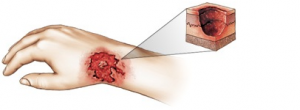A burn is a type of injury to the flesh caused by heat, electricity, chemicals, light, radiation, or friction. The three most common types of burns include thermal, chemical, and electrical. Thermal injuries include flame, scald, and contact. Managing burns is important because they are common, painful and can result in disfiguring and disabling scarring.
Four major classifications of burns
- First degree burns – it is superficial and usually distinguishes by red, dry, and edematous skin that is painful to touch. First degree burns involves only the epidermal layer of the skin.
- Second degree burns – two categories: superficial partial thickness and deep partial thickness. Superficial partial thickness is red, blistering, weeping, and moist edematous skin that is painful and sensitive to temperature. Deep partial thickness burns are pink and cherry red. In most severe case it can be mottled white. The burn involves the entire epidermis, multiple layers of the dermis, and the subcutaneous fat layer.
- Third degree burns – (full thickness) the skin is dry, leathery, and non-pliable. No blisters appear, but the skin does have a mixed white or waxy white appearance. There is usually no pain. This layer involves the epidermis, the majority of the dermal and fat layers, and the underlying fascial and muscular layers. Grafting is requires for this degree of burn.
- Fourth degree burns – is white to dark charred in color and dry. This burn involved the epidermis, dermis, fat, and commonly exposed bone and tendon. If the burned skin is not grafted, then it will not heal. Amputations are often required, and in the absence of surgical wound closure, death may result (Kennealey,Weiss, & Morgan, 2002).
OCCUPATIONAL THERAPY PERSPECTIVE
The occupational therapist focuses on maintaining range of motion (ROM), positioning, edema control and reduction, splinting, education, scar prevention and management, activity of daily living (ADL) adaptation and remediation, and return to occupation.
References
WebMD, article source: Burn, retreived from: http://firstaid.webmd.com/tc/burns-topic-overview
Atchison, Ben J. & Dirette, Dianne K., 2007. Conditions in Occupational Therapy: Effect of Occupational Performance.
Kennealey, Moya., Morgan, Marlene J., Weiss, Donna., 2004. A Practitioner’s Guide to Clinical Occupational Therapy.


